SKODA ROOMSTER 2012 1.G Owner's Manual
Manufacturer: SKODA, Model Year: 2012, Model line: ROOMSTER, Model: SKODA ROOMSTER 2012 1.GPages: 194, PDF Size: 4.8 MB
Page 171 of 194
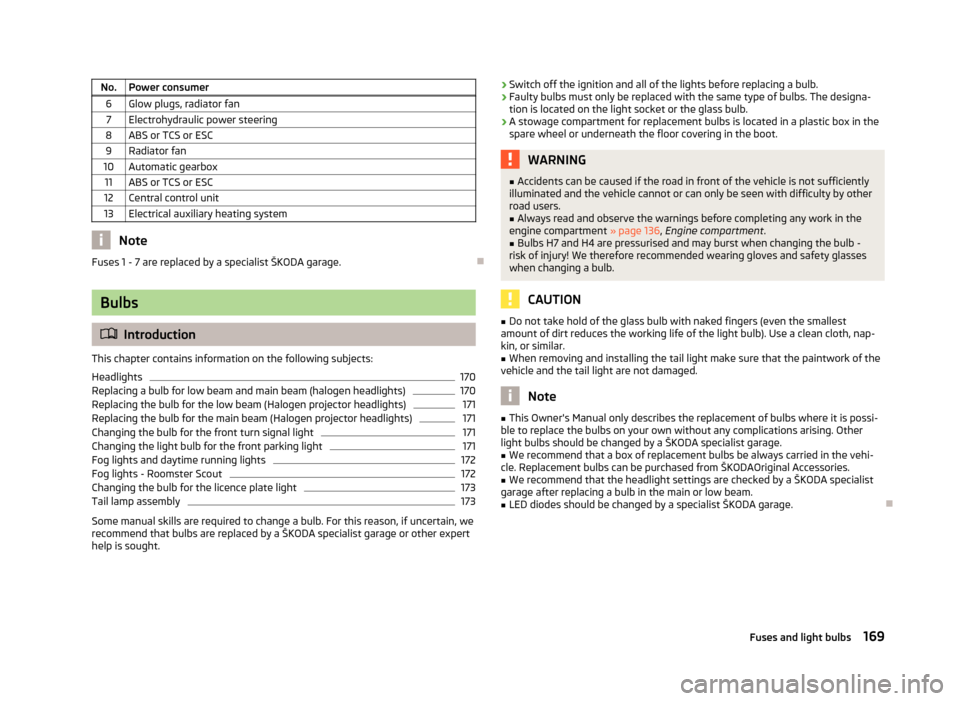
No. Power consumer
6 Glow plugs, radiator fan7 Electrohydraulic power steering
8 ABS or TCS or ESC 9 Radiator fan
10 Automatic gearbox 11 ABS or TCS or ESC
12 Central control unit
13 Electrical auxiliary heating system Note
Fuses 1 - 7 are replaced by a specialist ŠKODA garage. ÐBulbs
ä
Introduction
This chapter contains information on the following subjects:
Headlights 170
Replacing a bulb for low beam and main beam (halogen headlights) 170
Replacing the bulb for the low beam (Halogen projector headlights) 171
Replacing the bulb for the main beam (Halogen projector headlights) 171
Changing the bulb for the front turn signal light 171
Changing the light bulb for the front parking light 171
Fog lights and daytime running lights 172
Fog lights - Roomster Scout 172
Changing the bulb for the licence plate light 173
Tail lamp assembly 173
Some manual skills are required to change a bulb. For this reason, if uncertain, we
recommend that bulbs are replaced by a ŠKODA specialist garage or other expert
help is sought. ›
Switch off the ignition and all of the lights before replacing a bulb.
› Faulty bulbs must only be replaced with the same type of bulbs. The designa-
tion is located on the light socket or the glass bulb.
› A stowage compartment for replacement bulbs is located in a plastic box in the
spare wheel or underneath the floor covering in the boot. WARNING
■ Accidents can be caused if the road in front of the vehicle is not sufficiently
illuminated and the vehicle cannot or can only be seen with difficulty by other
road users.
■ Always read and observe the warnings before completing any work in the
engine compartment » page 136, Engine compartment .
■ Bulbs H7 and H4 are pressurised and may burst when changing the bulb -
risk of injury! We therefore recommended wearing gloves and safety glasses
when changing a bulb. CAUTION
■ Do not take hold of the glass bulb with naked fingers (even the smallest
amount of dirt reduces the working life of the light bulb). Use a clean cloth, nap-
kin, or similar. ■ When removing and installing the tail light make sure that the paintwork of the
vehicle and the tail light are not damaged. Note
■ This Owner's Manual only describes the replacement of bulbs where it is possi-
ble to replace the bulbs on your own without any complications arising. Other
light bulbs should be changed by a
ŠKODA specialist garage.
■ We recommend that a box of replacement bulbs be always carried in the vehi-
cle. Replacement bulbs can be purchased from
ŠKODAOriginal Accessories.
■ We recommend that the headlight settings are checked by a ŠKODA specialist
garage after replacing a bulb in the main or low beam.
■ LED diodes should be changed by a specialist ŠKODA garage. Ð
169
Fuses and light bulbs
Page 172 of 194
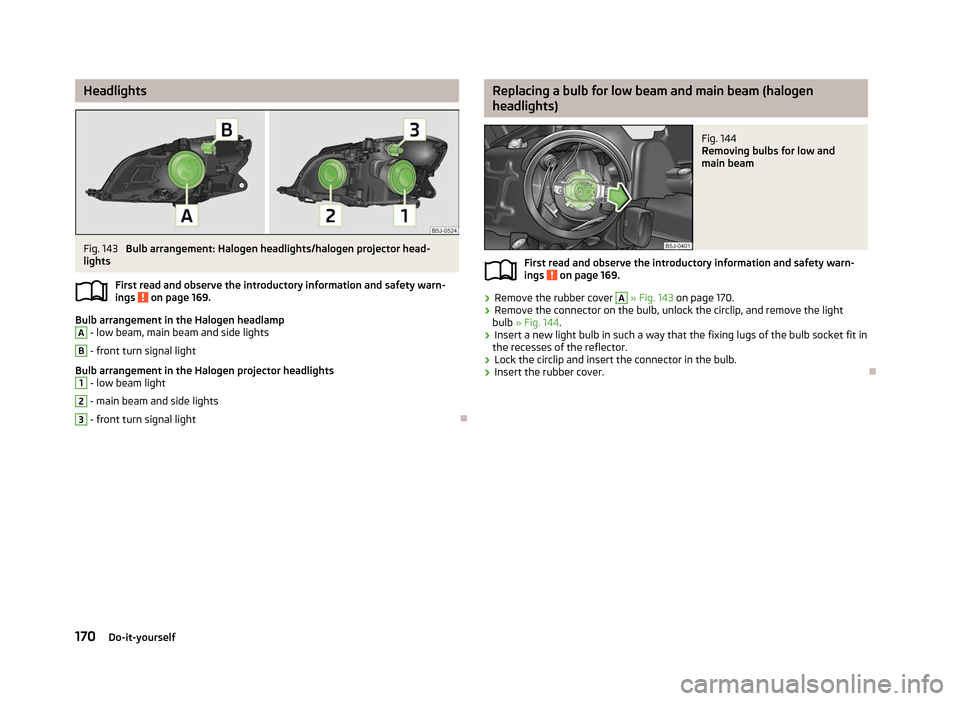
Headlights
Fig. 143
Bulb arrangement: Halogen headlights/halogen projector head-
lights
First read and observe the introductory information and safety warn-
ings on page 169.
Bulb arrangement in the Halogen headlamp
A
- low beam, main beam and side lights
B
- front turn signal light
Bulb arrangement in the Halogen projector headlights 1
- low beam light
2
- main beam and side lights
3
- front turn signal light
Ð
ä Replacing a bulb for low beam and main beam (halogen
headlights)
Fig. 144
Removing bulbs for low and
main beam
First read and observe the introductory information and safety warn-
ings on page 169.
›
Remove the rubber cover A
» Fig. 143 on page 170.
› Remove the connector on the bulb, unlock the circlip, and remove the light
bulb » Fig. 144.
› Insert a new light bulb in such a way that the fixing lugs of the bulb socket fit in
the recesses of the reflector.
› Lock the circlip and insert the connector in the bulb.
› Insert the rubber cover. Ð
ä
170 Do-it-yourself
Page 173 of 194
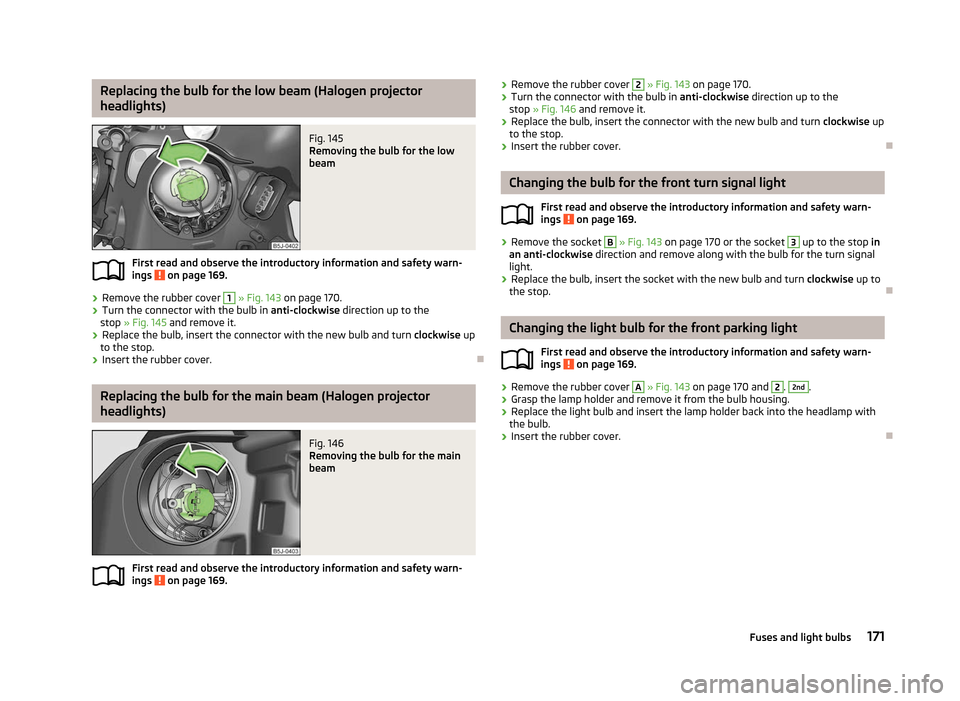
Replacing the bulb for the low beam (Halogen projector
headlights)
Fig. 145
Removing the bulb for the low
beam
First read and observe the introductory information and safety warn-
ings on page 169.
›
Remove the rubber cover 1
» Fig. 143 on page 170.
› Turn the connector with the bulb in
anti-clockwise direction up to the
stop » Fig. 145 and remove it.
› Replace the bulb, insert the connector with the new bulb and turn
clockwise up
to the stop.
› Insert the rubber cover. ÐReplacing the bulb for the main beam (Halogen projector
headlights)
Fig. 146
Removing the bulb for the main
beam
First read and observe the introductory information and safety warn-
ings on page 169.ä
ä ›
Remove the rubber cover 2
» Fig. 143 on page 170.
› Turn the connector with the bulb in
anti-clockwise direction up to the
stop » Fig. 146 and remove it.
› Replace the bulb, insert the connector with the new bulb and turn
clockwise up
to the stop.
› Insert the rubber cover. Ð Changing the bulb for the front turn signal light
First read and observe the introductory information and safety warn-
ings on page 169.
›
Remove the socket B
» Fig. 143 on page 170 or the socket 3
up to the stop
in
an anti-clockwise direction and remove along with the bulb for the turn signal
light.
› Replace the bulb, insert the socket with the new bulb and turn
clockwise up to
the stop. Ð Changing the light bulb for the front parking light
First read and observe the introductory information and safety warn-
ings on page 169.
›
Remove the rubber cover A
» Fig. 143 on page 170
and 2
. 2nd
.
› Grasp the lamp holder and remove it from the bulb housing.
› Replace the light bulb and insert the lamp holder back into the headlamp with
the bulb.
› Insert the rubber cover. Ð
ä
ä
171
Fuses and light bulbs
Page 174 of 194
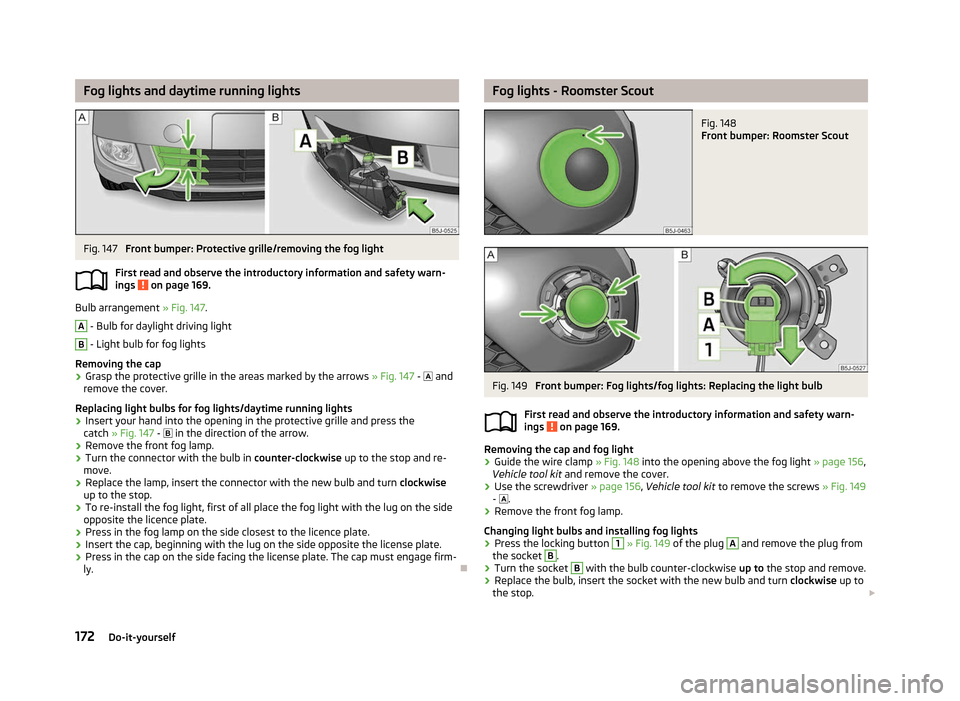
Fog lights and daytime running lights
Fig. 147
Front bumper: Protective grille/removing the fog light
First read and observe the introductory information and safety warn-
ings on page 169.
Bulb arrangement
» Fig. 147.A
- Bulb for daylight driving light
B
- Light bulb for fog lights
Removing the cap
› Grasp the protective grille in the areas marked by the arrows
» Fig. 147 - and
remove the cover.
Replacing light bulbs for fog lights/daytime running lights
› Insert your hand into the opening in the protective grille and press the
catch » Fig. 147 - in the direction of the arrow.
› Remove the front fog lamp.
› Turn the connector with the bulb in
counter-clockwise up to the stop and re-
move.
› Replace the lamp, insert the connector with the new bulb and turn
clockwise
up to the stop.
› To re-install the fog light, first of all place the fog light with the lug on the side
opposite the licence plate.
› Press in the fog lamp on the side closest to the licence plate.
› Insert the cap, beginning with the lug on the side opposite the license plate.
› Press in the cap on the side facing the license plate. The cap must engage firm-
ly. Ð
ä Fog lights - Roomster Scout
Fig. 148
Front bumper: Roomster Scout Fig. 149
Front bumper: Fog lights/fog lights: Replacing the light bulb
First read and observe the introductory information and safety warn-
ings on page 169.
Removing the cap and fog light
›
Guide the wire clamp
» Fig. 148 into the opening above the fog light » page 156,
Vehicle tool kit and remove the cover.
› Use the screwdriver
» page 156, Vehicle tool kit to remove the screws » Fig. 149
- .
› Remove the front fog lamp.
Changing light bulbs and installing fog lights
› Press the locking button 1
» Fig. 149
of the plug A
and remove the plug from
the socket B
.
› Turn the socket B
with the bulb counter-clockwise
up to the stop and remove.
› Replace the bulb, insert the socket with the new bulb and turn
clockwise up to
the stop. £
ä
172 Do-it-yourself
Page 175 of 194
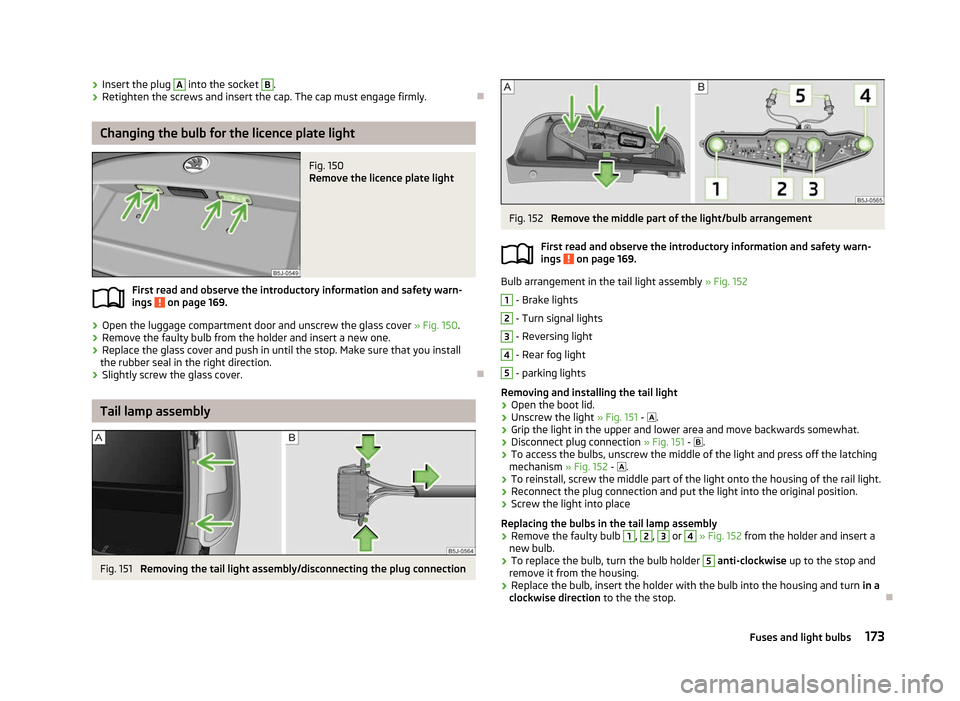
›
Insert the plug A
into the socket B
.
› Retighten the screws and insert the cap. The cap must engage firmly. ÐChanging the bulb for the licence plate light
Fig. 150
Remove the licence plate light
First read and observe the introductory information and safety warn-
ings on page 169.
›
Open the luggage compartment door and unscrew the glass cover
» Fig. 150.
› Remove the faulty bulb from the holder and insert a new one.
› Replace the glass cover and push in until the stop. Make sure that you install
the rubber seal in the right direction.
› Slightly screw the glass cover. ÐTail lamp assembly
Fig. 151
Removing the tail light assembly/disconnecting the plug connection
ä Fig. 152
Remove the middle part of the light/bulb arrangement
First read and observe the introductory information and safety warn-
ings on page 169.
Bulb arrangement in the tail light assembly
» Fig. 152 1
- Brake lights
2
- Turn signal lights
3
- Reversing light
4
- Rear fog light
5
- parking lights
Removing and installing the tail light
› Open the boot lid.
› Unscrew the light
» Fig. 151 - .
› Grip the light in the upper and lower area and move backwards somewhat.
› Disconnect plug connection
» Fig. 151 - .
› To access the bulbs, unscrew the middle of the light and press off the latching
mechanism » Fig. 152 - .
› To reinstall, screw the middle part of the light onto the housing of the rail light.
› Reconnect the plug connection and put the light into the original position.
› Screw the light into place
Replacing the bulbs in the tail lamp assembly
› Remove the faulty bulb 1
, 2
, 3
or 4
» Fig. 152 from the holder and insert a
new bulb.
› To replace the bulb, turn the bulb holder 5
anti-clockwise
up to the stop and
remove it from the housing.
› Replace the bulb, insert the holder with the bulb into the housing and turn
in a
clockwise direction to the the stop. Ð
ä
173
Fuses and light bulbs
Page 176 of 194
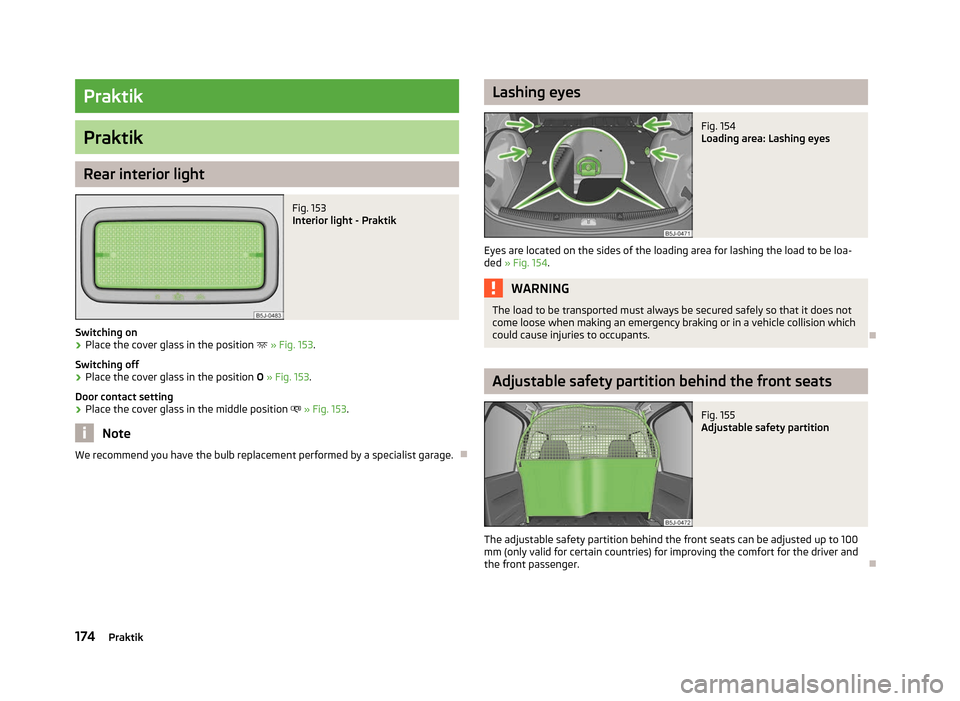
Praktik
Praktik
Rear interior light
Fig. 153
Interior light - Praktik
Switching on
› Place the cover glass in the position
» Fig. 153.
Switching off
› Place the cover glass in the position
O » Fig. 153.
Door contact setting
› Place the cover glass in the middle position
» Fig. 153. Note
We recommend you have the bulb replacement performed by a specialist garage. Ð Lashing eyes
Fig. 154
Loading area: Lashing eyes
Eyes are located on the sides of the loading area for lashing the load to be loa-
ded » Fig. 154 . WARNING
The load to be transported must always be secured safely so that it does not
come loose when making an emergency braking or in a vehicle collision which
could cause injuries to occupants. Ð Adjustable safety partition behind the front seats
Fig. 155
Adjustable safety partition
The adjustable safety partition behind the front seats can be adjusted up to 100
mm (only valid for certain countries) for improving the comfort for the driver and
the front passenger. Ð
174 Praktik
Page 177 of 194
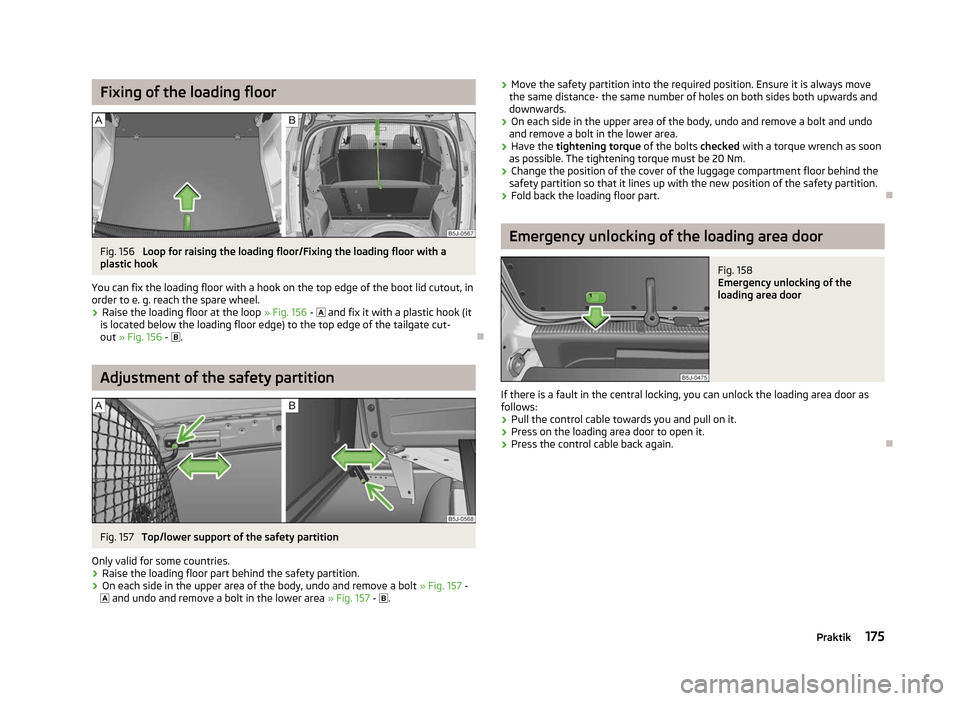
Fixing of the loading floor
Fig. 156
Loop for raising the loading floor/Fixing the loading floor with a
plastic hook
You can fix the loading floor with a hook on the top edge of the boot lid cutout, in
order to e. g. reach the spare wheel.
› Raise the loading floor at the loop
» Fig. 156 - and fix it with a plastic hook (it
is located below the loading floor edge) to the top edge of the tailgate cut-
out » Fig. 156 - . ÐAdjustment of the safety partition
Fig. 157
Top/lower support of the safety partition
Only valid for some countries. › Raise the loading floor part behind the safety partition.
› On each side in the upper area of the body, undo and remove a bolt
» Fig. 157 -
and undo and remove a bolt in the lower area » Fig. 157 - . ›
Move the safety partition into the required position. Ensure it is always move
the same distance- the same number of holes on both sides both upwards and
downwards.
› On each side in the upper area of the body, undo and remove a bolt and undo
and remove a bolt in the lower area.
› Have the
tightening torque of the bolts checked with a torque wrench as soon
as possible. The tightening torque must be 20 Nm.
› Change the position of the cover of the luggage compartment floor behind the
safety partition so that it lines up with the new position of the safety partition.
› Fold back the loading floor part. Ð Emergency unlocking of the loading area door
Fig. 158
Emergency unlocking of the
loading area door
If there is a fault in the central locking, you can unlock the loading area door as
follows:
› Pull the control cable towards you and pull on it.
› Press on the loading area door to open it.
› Press the control cable back again. Ð
175
Praktik
Page 178 of 194
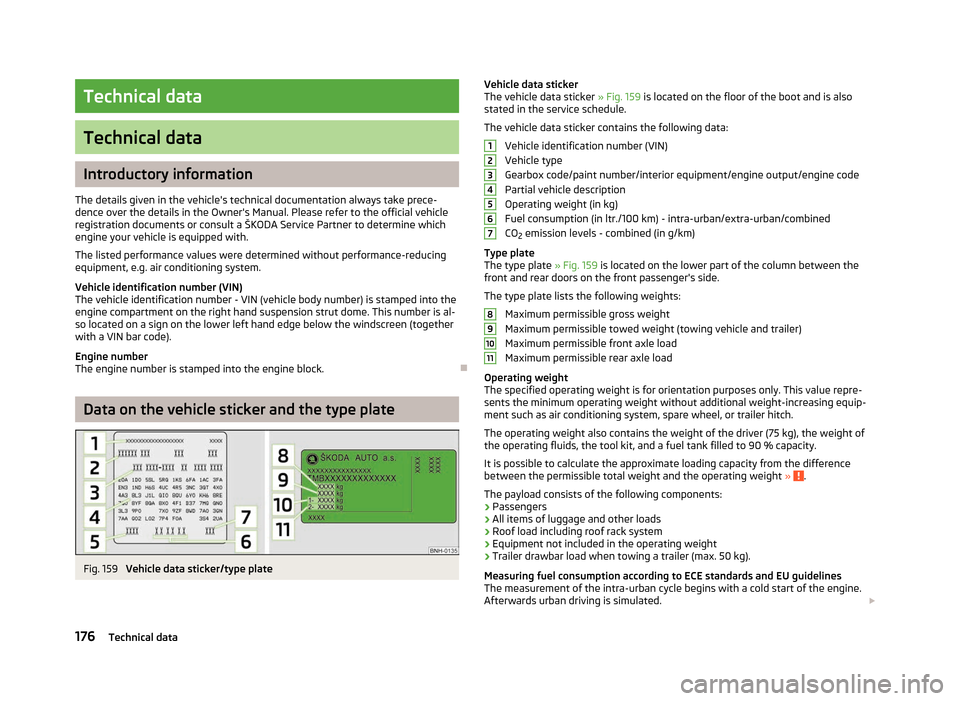
Technical data
Technical data
Introductory information
The details given in the vehicle's technical documentation always take prece-
dence over the details in the Owner's Manual. Please refer to the official vehicle
registration documents or consult a
ŠKODA Service Partner to determine which
engine your vehicle is equipped with.
The listed performance values were determined without performance-reducing
equipment, e.g. air conditioning system.
Vehicle identification number (VIN)
The vehicle identification number - VIN (vehicle body number) is stamped into the
engine compartment on the right hand suspension strut dome. This number is al-
so located on a sign on the lower left hand edge below the windscreen (together
with a VIN bar code).
Engine number
The engine number is stamped into the engine block. ÐData on the vehicle sticker and the type plate
Fig. 159
Vehicle data sticker/type plate Vehicle data sticker
The vehicle data sticker » Fig. 159 is located on the floor of the boot and is also
stated in the service schedule.
The vehicle data sticker contains the following data:
Vehicle identification number (VIN)
Vehicle type
Gearbox code/paint number/interior equipment/engine output/engine code
Partial vehicle description
Operating weight (in kg)
Fuel consumption (in ltr./100
km) - intra-urban/extra-urban/combined
CO 2 emission levels - combined (in g/km)
Type plate
The type plate » Fig. 159 is located on the lower part of the column between the
front and rear doors on the front passenger's side.
The type plate lists the following weights: Maximum permissible gross weight
Maximum permissible towed weight (towing vehicle and trailer)
Maximum permissible front axle load
Maximum permissible rear axle load
Operating weight
The specified operating weight is for orientation purposes only. This value repre-
sents the minimum operating weight without additional weight-increasing equip-
ment such as air conditioning system, spare wheel, or trailer hitch.
The operating weight also contains the weight of the driver (75 kg), the weight of
the operating fluids, the tool kit, and a fuel tank filled to 90 % capacity.
It is possible to calculate the approximate loading capacity from the difference
between the permissible total weight and the operating weight » .
The payload consists of the following components:
› Passengers
› All items of luggage and other loads
› Roof load including roof rack system
› Equipment not included in the operating weight
› Trailer drawbar load when towing a trailer (max. 50 kg).
Measuring fuel consumption according to ECE standards and EU guidelines
The measurement of the intra-urban cycle begins with a cold start of the engine.
Afterwards urban driving is simulated. £ 1
2
3
4
5
6
7
8
9
10
11
176
Technical data
Page 179 of 194
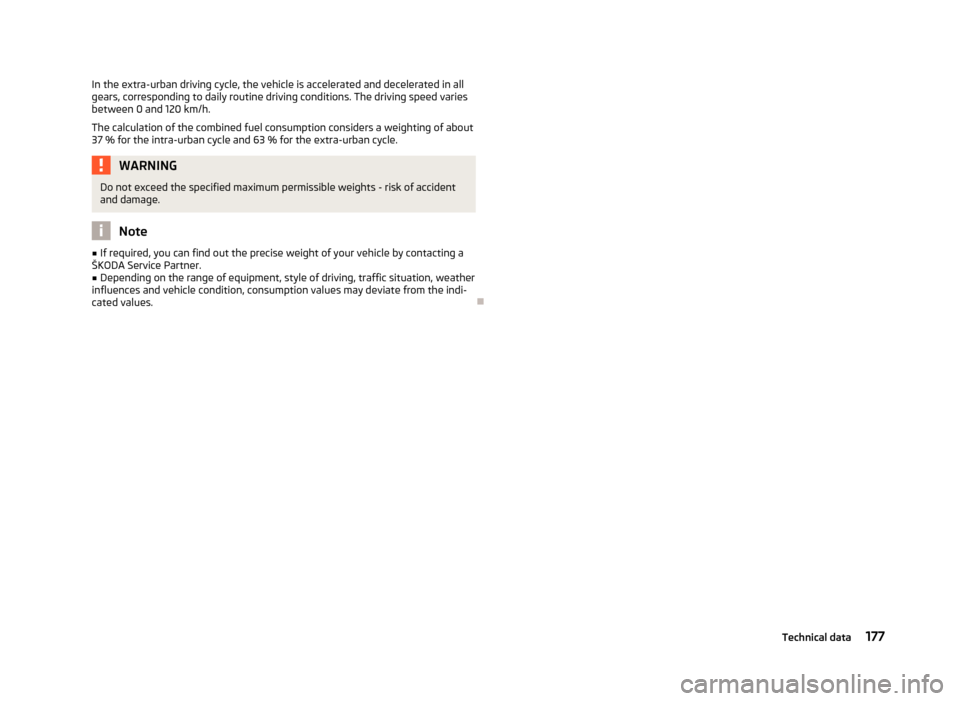
In the extra-urban driving cycle, the vehicle is accelerated and decelerated in all
gears, corresponding to daily routine driving conditions. The driving speed varies
between 0 and 120 km/h.
The calculation of the combined fuel consumption considers a weighting of about
37 % for the intra-urban cycle and 63 % for the extra-urban cycle. WARNING
Do not exceed the specified maximum permissible weights - risk of accident
and damage. Note
■ If required, you can find out the precise weight of your vehicle by contacting a
ŠKODA
Service Partner.
■ Depending on the range of equipment, style of driving, traffic situation, weather
influences and vehicle condition, consumption values may deviate from the indi-
cated values. Ð 177
Technical data
Page 180 of 194
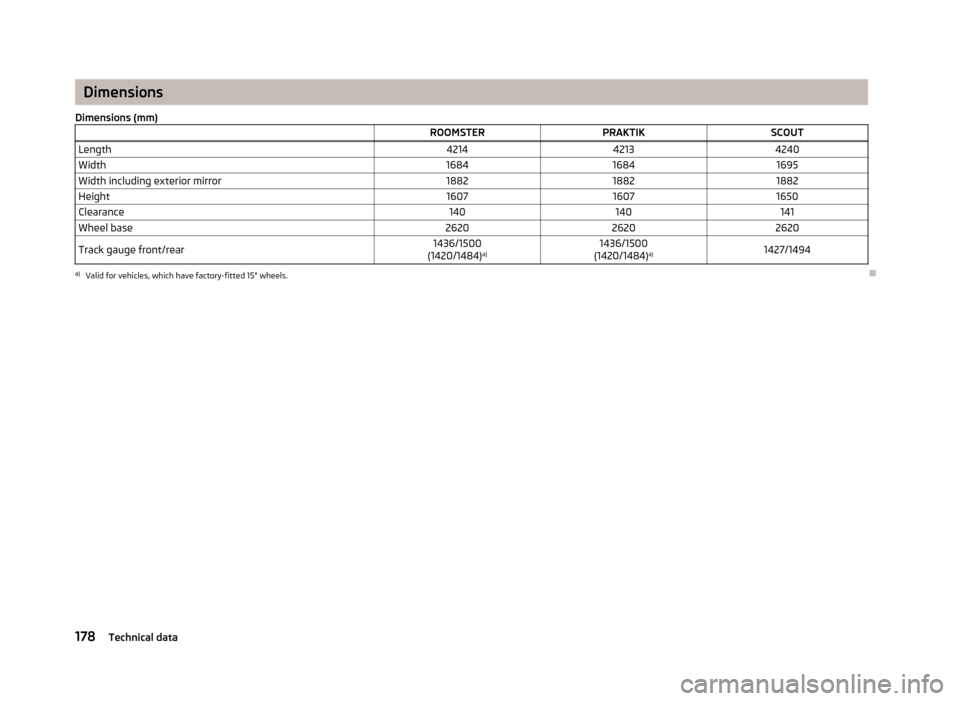
Dimensions
Dimensions (mm) ROOMSTERPRAKTIKSCOUT
Length 421442134240
Width 168416841695
Width including exterior mirror 188218821882
Height 160716071650
Clearance 140140141
Wheel base 262026202620
Track gauge front/rear 1436/1500
(1420/1484) a) 1436/1500
(1420/1484) a)
1427/1494a)
Valid for vehicles, which have factory-fitted 15" wheels. Ð178
Technical data